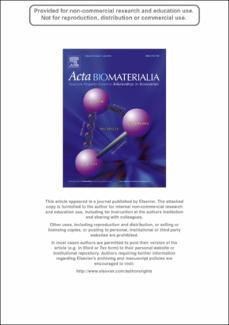| dc.contributor.author | Rupp, Frank | |
| dc.contributor.author | Gittens, Rolando A. | |
| dc.contributor.author | Scheideler, Lutz | |
| dc.contributor.author | Marmur, Abraham | |
| dc.contributor.author | Boyan, Barbara D. | |
| dc.contributor.author | Schwartz, Zvi | |
| dc.contributor.author | Geis-Gerstorfer, Jürgen | |
| dc.date.accessioned | 2020-08-08T18:16:54Z | |
| dc.date.available | 2020-08-08T18:16:54Z | |
| dc.date.issued | 2014-02-28 | |
| dc.identifier.other | doi.org/10.1016/j.actbio.2014.02.040 | |
| dc.identifier.uri | http://repositorio-indicasat.org.pa/handle/123456789/230 | |
| dc.description | The surface wettability of biomaterials determines the biological cascade of events at the biomaterial/ host interface. Wettability is modulated by surface characteristics, such as surface chemistry and surface topography. However, the design of current implant surfaces focuses mainly on specific micro- and nanotopographical features, and is still far from predicting the concomitant wetting behavior. There is an increasing interest in understanding the wetting mechanisms of implant surfaces and the role of wettability in the biological response at the implant/bone or implant/soft tissue interface. Fundamental knowledge related to the influence of surface roughness (i.e. a quantification of surface topography) on titanium and titanium alloy surface wettability, and the different associated wetting regimes, can improve our understanding of the role of wettability of rough implant surfaces on the biological outcome. Such an approach has been applied to biomaterial surfaces only in a limited way. Focusing on titanium dental and orthopaedic implants, the present study reviews the current knowledge on the wettability of biomaterial surfaces, encompassing basic and applied aspects that include measurement techniques, thermodynamic aspects of wetting and models predicting topographical and roughness effects on the wetting behavior. | en_US |
| dc.description.abstract | The surface wettability of biomaterials determines the biological cascade of events at the biomaterial/ host interface. Wettability is modulated by surface characteristics, such as surface chemistry and surface topography. However, the design of current implant surfaces focuses mainly on specific micro- and nanotopographical features, and is still far from predicting the concomitant wetting behavior. There is an increasing interest in understanding the wetting mechanisms of implant surfaces and the role of wettability in the biological response at the implant/bone or implant/soft tissue interface. Fundamental knowledge related to the influence of surface roughness (i.e. a quantification of surface topography) on titanium and titanium alloy surface wettability, and the different associated wetting regimes, can improve our understanding of the role of wettability of rough implant surfaces on the biological outcome. Such an approach has been applied to biomaterial surfaces only in a limited way. Focusing on titanium dental and orthopaedic implants, the present study reviews the current knowledge on the wettability of biomaterial surfaces, encompassing basic and applied aspects that include measurement techniques, thermodynamic aspects of wetting and models predicting topographical and roughness effects on the wetting behavior. | en_US |
| dc.format | application/pdf | |
| dc.language.iso | eng | en_US |
| dc.rights | Info:eu-repo/semantics/openAccess | |
| dc.rights | https://creativecommons.org/licenses/by/4.0/deed.es | |
| dc.subject | Wettability Hydrophilicity | en_US |
| dc.subject | Surface energy Contact | en_US |
| dc.subject | angle hysteresis Roughness induced wetting | en_US |
| dc.title | A review on the wettability of dental implant surfaces I: Theoretical and experimental aspects | en_US |
| dc.type | info:eu-repo/semantics/article | en_US |
| dc.type | Info:eu-repo/semantics/publishedversion | |

